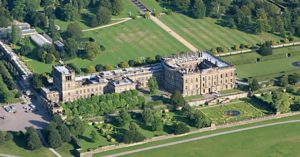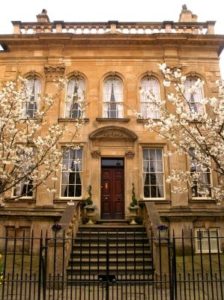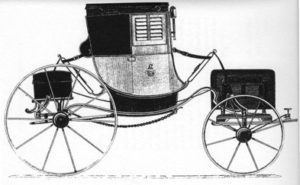 Money is not an acceptable topic of conversation among the gently-bred, so I beg forgiveness for breaking the taboo. We people our books with wealthy, dashing characters who are the equivalents of today’s super rich –dukes and earls instead of billionaire corporate tycoons –but haven’t you ever wondered, how rich was “rich” in our period? (Alas, I am STILL working on my revisions of The Magnificent Marquess, so no announcement yet that it is up and available! But very soon….)
Money is not an acceptable topic of conversation among the gently-bred, so I beg forgiveness for breaking the taboo. We people our books with wealthy, dashing characters who are the equivalents of today’s super rich –dukes and earls instead of billionaire corporate tycoons –but haven’t you ever wondered, how rich was “rich” in our period? (Alas, I am STILL working on my revisions of The Magnificent Marquess, so no announcement yet that it is up and available! But very soon….)
An income of £10,000 was considered a threshold to “live the good life” among the Beau Monde, with a regular social life in London as well as the country. This is the income Jane Austen gives Darcy. How far beyond that level of wealth could we expect to find in Regency society? A modest estate in Ireland was said to have paid £1,200 a year, enough to live on “comfortably”. Yet in 1815, just the cost of maintaining a stable for hunting could equal that amount. Jane Austen’s Bennett family lived on an entailed estate that paid £2,000 a year.
 Land was the greatest measure of wealth, and in the Regency period, most of the usable land was tied up in great estates held by the peerage and the landed gentry, so acquiring new land ownership was difficult to accomplish. Land provided the income, through the rents and profit-shares from tenant farmers. At least 10,000 acres were generally needed to yield the requisite £10,000 of income.
Land was the greatest measure of wealth, and in the Regency period, most of the usable land was tied up in great estates held by the peerage and the landed gentry, so acquiring new land ownership was difficult to accomplish. Land provided the income, through the rents and profit-shares from tenant farmers. At least 10,000 acres were generally needed to yield the requisite £10,000 of income.
A quick survey of the holdings of modern-day descendants of peers from our period yields some insight. The family seat of the Earls of Pembroke (current one is the17th), for example, is Wilton House outside of Salisbury, with 16,000 acres. The Earl of Bathurst’s seat at Cirencester Park is 15,000 acres. Those are single holdings. The current Duke of Devonshire owns 70,000 acres in three counties, the 175-room Chatsworth, and a 200-room castle in Eire that the family rents out. The Duke of Argyll has 81,000 acres. The rents from owning land in London also provided a source of great wealth for some. The Portman riches stem from 100 acres of London real estate held since 1553.
What were other sources of wealth? Government or court appointments with a nice yearly stipend could supplement a rent-based income quite handsomely. There was no investing in a stock market as we know it today, but Miss Crawley in Thackeray’s Vanity Fair, has £70,000 in the 5% funds, which were securities in the national debt (kind of like U.S. Treasury Bonds). This would have given her a yearly income of £3,500. Other investments, for the less well-to-do, were the consols, which paid 3% and were a set of annuities that had been consolidated into one fund. Brummel was said to have made £30,000/year with successful betting on horse races, until his luck turned against him.
How much was a pound worth? Sources vary on this, and equivalents are hard to fix, since modern life is so very different in most ways. How do you compare the cost-of-living? No one is buying carriages these days, and we aren’t using candles to light our homes. I have notes that say a Regency era pound was worth about $50 in 1990’s dollars, but I have also seen a valuation of $33 given for 1988 dollars, and more than twice as much elsewhere! If anyone has more recent figures, or different info, please share? If you use the $50 value, Darcy’s annual income was $500,000 –a handsome sum, to be sure, but far from princely. A man who had an income of £30,000, however, which many of the greater peerage did, had 1.5 million dollars coming in. Hm, maybe now in 2017, the $100= pound valuation does begin to look appropriate? Inflation!!
 Taxes were perhaps the heaviest burden on the English populace. Such a vast array of daily necessities and features of good living were taxed, the ability to have or use them was itself a fine mark of one’s status. In The Magnificent Marquess, my heroine is impressed when she sees that Lord Milbourne, my hero, is extravagantly burning candles in his music room –during the day!! Everything from candles to soap was subject to taxation, including windows and servants. Male servants were subject to a higher tax than females. Employers paid a guinea per male servant (21 shillings, or £1.1), a tax instituted in 1777 and not lifted until 1937.
Taxes were perhaps the heaviest burden on the English populace. Such a vast array of daily necessities and features of good living were taxed, the ability to have or use them was itself a fine mark of one’s status. In The Magnificent Marquess, my heroine is impressed when she sees that Lord Milbourne, my hero, is extravagantly burning candles in his music room –during the day!! Everything from candles to soap was subject to taxation, including windows and servants. Male servants were subject to a higher tax than females. Employers paid a guinea per male servant (21 shillings, or £1.1), a tax instituted in 1777 and not lifted until 1937.
Servants were a necessity for the upper classes. Since a large country estate would include a sizeable house, plus park, gardens, stables, paddocks, and a home farm in addition to all the tenant farms, the army of servants required could be large. Blenheim was said to have employed 180 servants, including both indoor and outdoor. Lord Fitzwilliam employed 70 servants to keep Wentworth Woodhouse running. In the 18th century the “average” number of servants to keep a large country house running was 40.
a sizeable house, plus park, gardens, stables, paddocks, and a home farm in addition to all the tenant farms, the army of servants required could be large. Blenheim was said to have employed 180 servants, including both indoor and outdoor. Lord Fitzwilliam employed 70 servants to keep Wentworth Woodhouse running. In the 18th century the “average” number of servants to keep a large country house running was 40.
The wealthiest landowners might own several estates in multiple counties, and while house servants might travel with them from site to site, the servants tending to the physical aspects of each estate stayed there to tend to their continuing duties, requiring a separate set of such workers for each estate. This would include stewards, gamekeepers, gardeners, parkkeepers, dairymaids, stablehands, and a minimal house staff, etc.
 The cost of living fashionably in London varied, of course. The Duke of Northumberland might spend £10,000 to run his London establishment in 1810, but if you were of more modest means, like the Bennetts, the average cost of running a London townhouse would be about your entire income for the year, so you would rent one, and only when necessary.
The cost of living fashionably in London varied, of course. The Duke of Northumberland might spend £10,000 to run his London establishment in 1810, but if you were of more modest means, like the Bennetts, the average cost of running a London townhouse would be about your entire income for the year, so you would rent one, and only when necessary.
The cost of maintaining a London house did not include such things as a season subscription to a box at the Royal Opera House, which could cost as much as £2,500 (I assume depending on the box location). A 3 month subscription to Almack’s for the weekly Wednesday night dinners with supper “only” cost 10 guineas, or £10.10, but was worth a great deal more in terms of social consequence!
That £10 doesn’t sound like much, but consider that a governess might only be paid about £12 per year (although she also received room and board); a Private in the military might only earn £7.7 per year after deductions for food and some other expenses. Compare the Bennett’s income to that of an average clergyman, who might be paid £150/year, or less. Curates might earn £50/year if they were fortunate. Compare that to Byron’s rent for his London lodgings, at 4 guineas per week, or about £230 a year.
 Other trappings of wealth were also dear. A carriage could cost between 45 and 100 guineas ($2,475-$5,500 @ $50=pound), depending on the size and style; a pair of horses to pull that carriage could cost another 50-65 guineas. (Then you might also need a coachman to drive it.) Renovations to a London house or country seat could run into hundreds of thousands of pounds: the Londonderrys spent £200,000 on Holdernesse House, and the Lambs spent £100,000 on Melbourne Park. Lavish entertaining was expected of the rich. In 1799 the Duke of Rutland turned 21 and spent £5,000 for food and entertainment for a 3-day celebration at Belvoir Castle.
Other trappings of wealth were also dear. A carriage could cost between 45 and 100 guineas ($2,475-$5,500 @ $50=pound), depending on the size and style; a pair of horses to pull that carriage could cost another 50-65 guineas. (Then you might also need a coachman to drive it.) Renovations to a London house or country seat could run into hundreds of thousands of pounds: the Londonderrys spent £200,000 on Holdernesse House, and the Lambs spent £100,000 on Melbourne Park. Lavish entertaining was expected of the rich. In 1799 the Duke of Rutland turned 21 and spent £5,000 for food and entertainment for a 3-day celebration at Belvoir Castle.
If you’d like to read more, here are some additional sources for information of this sort:
http://web.stanford.edu/~steener/su02/english132/conversions.htm (using the 1988 valuation, offers tables to compare Jane Austen characters’ incomes and wealth, by books, also offers a list of typical Victorian incomes.
https://janeaustensworld.wordpress.com/tag/cost-of-living-in-regency-england/ (excellent article focused on Sense & Sensibility, but also including links to additional articles)
http://haleywhitehall.com/wealth-position-regency-england/ (nice article contrasting Darcy and Bingley to explain their respective social status)
How rich are your characters, or favorite heroes and heroines you’ve read? How rich do you want your fantasy heroes to be, or don’t you care? Have any favorite anecdotes of Regency extravagance you want to share?

Comparing worth is always difficult because of intangibles. I am dissatisfied with most of the comparison charts.
A very interesting and well researched blog.
The Regency Duke of Devonshire had nine houses on seven estates or seven houses on nine estates. ( I keep forgetting) One duke had 27 advowsons ( livings) to which he could appoint a clergyman. Many had control of seats in the House of Commons. Others owned race horses or had shares in shipping ventures or the East India company. Earl Spencer’s family have owned that house and estate for over 500 years, It would be interesting to learn how they, and others who have held on to property for ages , managed what with the rule against perpetuities and laws against entails. We tend to forget that the squares in Mayfair were named after the families that owned them and that some of the families still do own the ground.
The comparison of wealth and living standards is inevitable though hard to measure. A footman who received £10 a year had few expenses as food, lodging and clothes were usually included at work.
Nancy, thanks so much for adding this info! It really is a big enough topic to do a whole book…. I agree about the frustration with some of the charts out there. I suspect the problem is that you can’t do a “straight across the board” equivalency rating, but people try, to keep it simple. I see so many parallels with our present day, though, in the huge gap between the very rich and the very poor. That was real, not just a product of our romantic fantasies. I try to make my characters awake to it. 🙂
I think your numbers are a little low. The trouble is that a value calculated by reference to inflation gives a figure which fails to take account of many basic items being far cheaper then, in terms of how long you have to work to earn their cost, than today. If you take the typical annual earnings of a basic artisan in Regency times (say £50 a year) and compare it to today’s average annual wage for the unskilled (say £20,000), you get an answer that suggests Regency figures need to be multiplied by 500! This seems way too high and is probably caused by our national wealth and living standards being so much higher than theirs. I usually work on about half that figure, which would give Mr Darcy an annual income of some £2.5 million ($3 million) — still less than a good many CEOs today.
William, thanks so much for commenting! Yes, I think you are right that in some areas we need to use a much higher figure –maybe the hardest trick is to figure out which ones! I do think salaries of the very rich today is one area. When I looked at what Darcy’s income would be at $100 = pound, or at what those 30,000-pound incomes would be, it still seemed low. But for other kinds of things that rate seemed much too high. A complex subject indeed!
Wonderful post and gives a great idea of the relative wealth of our Regency heroes and heroines!
Louisa, thanks for dropping in! Sorry for the slow reply –I went off to a writing retreat for the weekend and thought I would have Internet access, but then didn’t!
It wasn’t just the cost of the horse or horses. There was also the upkeep.
Jane, that’s so true! The “ripple” effect we don’t always consider…. feed, care, stabling, stablehands, blacksmith, grooms, etc!! And carriages needed maintenance, too. All very costly. Thanks for adding your insight!
I enjoyed your post so much! Please do write a book on the topic 😉 I’ve also tried researching values between today and Victorian era, which is what I write. I’ve used this website (https://www.measuringworth.com/exchange/), but as you and others have pointed out, it’s trickier than just numbers because of the differences in Regency/Victorian vs modern standards of living, number of hours in a work week, etc. I believe we have quite a bit more leisure – partly because of technology/machines and partly because of labor laws – than our Regency counterparts. I understand that domestic servants, for example, worked 15-18 hour days, day in and day out. Again, thank you for an interesting and well-researched post!
Tory, thank you so much for sharing that website –it is awesome!!! A new research toy to play with makes me so happy!! I plugged in the value of a pound in 1816 converted to 2017 and this is what it said:
“When using the CPI/RPI, the (average) value in 2014 of £1 from 1816 is $95.90. The range of values is from $61.50 to $126.00.” That sounds just right to me –very helpful!!
I think you might be mistaken about the existence of a Stock Exchange in Regency England. The formal Exchange opened in 1802. Government bonds during this period paid about 3%, so when Austen mentions “the five percents” or estimates Bingley to be making between 4 and 5 percent on his capital, she is talking about the Funds, or the private bonds and other things traded on the Exchange.
This idea of 10,000L being necessary to be part of the Quality in London (which seems to originate with Georgette Heyer and the various sourcebooks written based on her research) fascinates me because it does NOT match up with anything Austen says. Many of her high society characters exist in London on considerably less (John Knightley lives here; Mr. Bingley, Sir Thomas Bertram, Henry Crawford, Robert Ferrars, Colonel Brandon, and others all live part of the year in London). I’ve been trying to track this down for a while and that’s how I ended up here.
[…] You might find this article interesting: https://riskyregencies.com/2017/02/03/how-rich-was-rich/ […]
Thank you for the nice clear explanation of Funds and Consols, I had some difficulty finding the information until I found your site. Very useful!